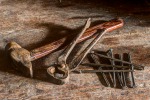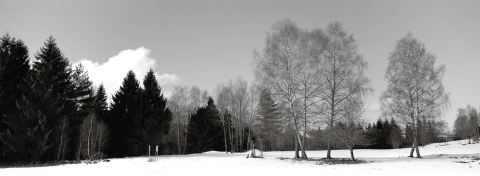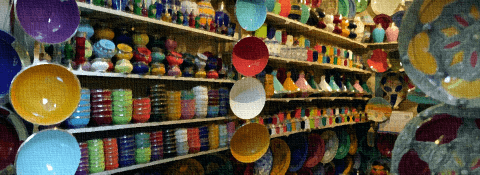Painted with light: Fine art photography prints
Buying fine art photography prints isn't exactly rocket science. However, if your last dealing with wall decoration was pinning a poster in a shared flat, you may want to listen to some advice.
You may want to rotate your phone in order to improve your browsing experience on this site.
Fine print first
"Fine art" is rather hard to define. Like many things related to arts in general and photography in particular, what makes fine art photography is mostly – or solely – in the eye of the beholder. One man's fine art print is a pure waste of material to someone else.
It's definitely not about money. An image from a point-and-shoot camera can end up more engaging than one from an expensive SLR endowed with first-class optics.
Neither is it about being classic. What we consider classic now, wasn't it at the moment of its creation. "Modern classic" is a contradiction; only time will tell.
So, what's then? In my opinion, thought and heart which go into an image make it art. To qualify as fine art, it needs a viewer who deems it as such.
How to approach fine art photography prints
Choosing a photography print you consider fine art is no easy trick. After all, it is supposed to stay before your face for quite a long time. Make sure you like it. If it's destined for your home, make sure your family likes it, too. If they don't, try hard to convince them but be prepared to compromise.
Then consider the following.
See it in context
Select the image carefully according to its setting. A subject suitable, say, for a bedroom might be inappropriate in an office – and vice versa.
Landscape photographs are probably most versatile, as they will fit virtually anywhere. The same goes for flowers. Still lifes, especially those depicting food and tableware in the tradition of old painters, will look great in a kitchen or a dining room. Cityscapes and examples of modern architecture are better used in public and business spaces – they don't seem very inviting elsewhere, perhaps save for young, single households. Pictures of animals suit children's rooms best, the younger the children the better.
Portraits are rather troublesome. Small snapshots of family gatherings are perfectly fitting for any tabletop and every wall. However, problems get bigger as image dimensions grow. It also goes without saying that pictures of anyone outside your close family look strange in your surroundings if you are over 17.
Size does matter
If you know where you'd like to place your new image, you can probably figure how big it can be printed at most. However, you should also take into account the distance from which it will be looked at.
While our eyes' field of view extends horizontally over almost 180°, we are only able to perceive something "at a glance" from distances starting at 1.5 times its width (and 2 times is better still). This explains why we are pretty uncomfortable when sitting too close to the screen at a cinema: we constantly have to turn our heads to keep up with everything going on in front of us.
Large images require more space in front of them to be viewed enjoyably. Consider this when planning your purchase.
Colour it in
Think about predominant colours in the image vs. those in its intended location. Frame tonality, wall paint or paper, hangings, furniture, even book spines – pay attention to everything that meets the eye when looking at the image. Avoid biting combinations, as you would while composing your images.
Black-and-white and monochrome tints seem a safe bet, especially in an office environment. There's no rule without exception, though – use your judgement.
Mind you, a wall painted orange will prove a major challenge.
Put it in frame
The frame is important, the more so the bigger your print. The ideal frame complements the image without distracting from it. Plain, not too wide varieties made of wood or metal provide the most natural appearance. Frameless mountings can create a striking illusion of images hovering off the wall.
“It's funny how the beauty of art has so much more to do with the frame than the artwork itself.”
Chuck Palahniuk, Choke
Smaller pictures of different sizes, framed behind a cardboard mount and seemingly hung without particular order on the same wall, lend a gallery-like feel to your collection. This style, known as salon hang, was very popular in 18th century Europe.
All that glitters...
You might have guessed – is not gold. Shiny surfaces – glass, lamination, paper – between your eyes and your print are an obstacle. If you have a choice, opt for matte over glossy alternatives. Otherwise, invest some time to find a place for your image largely free from incident light.
Bottom line
Mind the height at which you place the image. Ensure it remains comfortable to look at for those it is intended for – in a children's room, ask the children.
Set an example
You would know if you needed something, right? Well, with art it's probably not that simple. You don't really need it. You can perfectly get along without and not even notice you're missing something.
But if you think about it... Wouldn't it be nice to have something in your home providing relaxation and comfort and adding style to your surroundings at the same time?
Isn't it time to give a finishing touch to that corner of your house?
Don't you want something to look at during the meetings in your office other than charts and diagrams? Wouldn't it help your employees to have something else before their eyes in addition to quarter targets?
So, are you actually looking for fine art photography prints? Then be sure to check a selection of my best images, now ready to order from this site!
For some inspirational ideas in home and office design, follow my dedicated board on Pinterest!
Tags: #fineartphotography #fillyourwalls #phototips
Other photography tips
- Landscape photography composition tips
- Your mastery of photography composition is what ultimately makes your images. Read here how to excel at it in order to engage your viewers!
- Black & white landscape photography
- Black-and-white photography is very much alive, and landscapes in black and white still look as stunning as in Ansel Adams's day. Be sure to check the article if you'd like to try your hand at this classic and fascinating technique.
- Landscape photography equipment essentials
- Looking for a new camera or another piece of gear? Find answers to your questions, along with some advice and recommendations!
- Fine art photography prints
- And now for something completely different… My thoughts and advice on choosing and using fine art photography prints.
- How to photograph waterfalls
- If your waterfall images are not up to the expectations of your friends, nor to your own satisfaction, try these easy to follow tips to make them shine!
- Marketing fine art photography
- This newsletter issue is about creating your brand and marketing your work, told by those who've been there and done exactly that.
- What is legal to photograph outdoors
- Ever thought about copyright laws having two sides? Your photography can violate them, too. Be sure to know what to photograph, where without getting into trouble.
- How to use Photoshop
- In a dedicated newsletter issue, join me as I show how I use Photoshop to edit my images, and learn some funny facts about the application while at it.
- Wildlife photography tips
- No purchase necessary: Learn how to photograph wildlife for best possible results with your usual equipment.
- Art seascapes
- As November closes in, we take Ishmael's, of Moby Dick, advice and get to sea as soon as we can, led by some highly inspirational examples.
- Winter landscape photography tips
- "Winter landscape" may not sound as exciting as, say, "summer beach", not to everybody, for sure. But if it does to you, there is much to discover outdoors in this time of the year, too. Dress warmly and come on outside!
- Best Adobe Photoshop tips
- We recall some Photoshop basics, like layers, and proceed with more advanced topics, like masks, selective channel editing, converting colour to black and white, and output sharpening.
Tell me what you think!
Is it useful 👍? Awful 👎? Leave a message! Your comments help make this site better (and give me a kick—one way or another).
Popular articles
-
A kind of magic
If a digital picture has to be seen in the real world, printed on a real medium and displayed in a real showcase, its transition from RAW to real is better done in an old school image editor. Enter A…
-
A duck for a dog
If you got your own place on the Internet, helping your visitors find what they are looking for is a great way to engage them and keep them staying a bit longer. A custom site search can achieve just …
-
"Might as well have the best"
Aiming for better images? Think better lenses! This is your most important piece of gear, so you better get it sorted out. — Need some advice?


 Become a patron for
Become a patron for